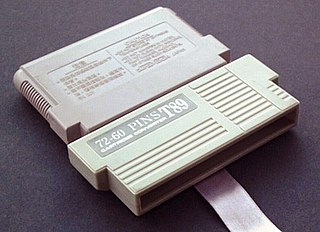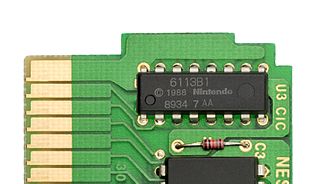
The Sega Master System is a third-generation 8-bit home video game console manufactured by Sega. It was originally a remodeled export version of the Sega Mark III, the third iteration of the SG-1000 series of consoles, which was released in Japan in 1985 and featured enhanced graphical capabilities over its predecessors. The Master System launched in North America in 1986, followed by Europe in 1987, and Brazil in 1989. A Japanese version of the Master System was also launched in 1987, which features a few enhancements over the export models : a built-in FM audio chip, a rapid-fire switch, and a dedicated port for the 3D glasses. The Master System II, a cheaper model, was released in 1990 in North America and Europe.

The Aladdin Deck Enhancer is a system-enhancing adaptor to use Compact Cartridges on the Nintendo Entertainment System. It was produced by Camerica and developed by Codemasters but not licensed by Nintendo. It is similar to the Datach system for the Famicom, but without the Barcode feature. It was released in November 1992, with its planned library to reach a total 24 games by the end of 1993. However, only seven games were actually released.

The New-Style NES is a compact cost-reduced redesigned version of the home video game console of the same name released by Nintendo in 1993.
Game Genie is the name of a line of video game cheat cartridges originally designed by Codemasters and sold by Camerica and Galoob. The first device in the series was released in 1990 for the Nintendo Entertainment System, with subsequent devices released for the Super NES, Game Boy, Genesis, and Game Gear. All the devices temporarily modify game data, allowing the player to cheat, manipulate various aspects of games, and sometimes access unused assets and functions. Five million units of the original Game Genie products were sold worldwide, and most video game console emulators feature Game Genie code support. Emulators that have Game Genie support also allow a near-unlimited number of codes to be entered whereas the actual products have a much smaller limit, between three and six codes.
A regional lockout is a class of digital rights management preventing the use of a certain product or service, such as multimedia or a hardware device, outside a certain region or territory. A regional lockout may be enforced through physical means, through technological means such as detecting the user's IP address or using an identifying code, or through unintentional means introduced by devices only supporting certain regional technologies.
Following the popularity and longevity of the Nintendo Entertainment System, the system has seen many clone video game consoles. Such clones are colloquially called Famiclones, and are electronic hardware devices designed to replicate the workings of, and play games designed for, the NES and Famicom. Hundreds of unauthorized clones and unlicensed copies have been made available since the height of the NES popularity in the late 1980s. The technology employed in such clones has evolved over the years: while the earliest clones feature a printed circuit board containing custom or third party integrated circuits (ICs), more recent (post-1996) clones utilize single chip designs, with a custom ASIC which simulates the functionality of the original hardware, and often includes one or more on-board games. Most devices originate in China and Taiwan, and less commonly South Korea.

The T89 cartridge converter is a 60 to 72 pin adapter that allows NES owners to plug a 60-pin Famicom game into a 72-pin-based NES. The cartridge required the user to have the Famicom cartridge label to face the back as otherwise it would cause damage to the cart and/or system. There is a fabric tab on the convert to allow the easy removal of the convert from the original front-loading NES and the subsequent top loader.

The Super 8, also sold under the title Tri-star or Tristar, is an unlicensed video game peripheral released in 1995 for the Super Nintendo Entertainment System designed to allow the system to run games developed for the Nintendo Entertainment System. The Super 8 utilized an NES-on-a-chip integrated circuit to duplicate the functionality of the original NES hardware, and connected to the SNES's own cartridge slot.

Home Entertainment Suppliers Pty. Ltd. is an Australian company that distributes computer games and gaming equipment. HES' offices are based in Riverwood, Sydney. HES's founder and managing director is MR Sebastian Giompaolo.
Import gamers are a subset of the video game player community that take part in the practice of playing video games from another region, usually from Japan where the majority of games for certain systems originate.

Micro Genius is a brand name used for Famicom clone consoles marketed in several countries around the world, particularly in areas where Nintendo consoles were not readily available, including the Middle East, Southeast Asia, South America, Eastern Europe, South Africa and East Asian countries excluding Japan and South Korea. The name was initially and most famously used by TXC Corporation for its range of Taiwanese-made Famicom clones, software and accessories, but later passed to other companies and remains in use today on rebranded Chinese Famicom clones and LCD games.

The Twin Famicom is a home video game console that was produced by Sharp Corporation in 1986 and was only released in Japan. It is a licensed Nintendo product that combines the Family Computer (Famicom) and the Family Computer Disk System (FDS) into a single piece of hardware. Sharp removed most Nintendo branding from the system, even going as far as to remove the "Nintendo" branding from the Famicom Disk System startup, replacing it with the same "FAMICOM" logo used on the system itself.

The Datach or Datach Joint ROM System, is an aftermarket enhancement accessory by Bandai for the Family Computer, allowing the system to play select compatible games. Released on December 29, 1992, it is packaged with one game, Dragon Ball Z: Gekitō Tenkaichi Budokai. Six other games were released for it, including one of the final games for the Famicom system in 1994. It is one of two mini systems compatible with the NES or Famicom, the other being the Aladdin Deck Enhancer.
The list of Nintendo 64 accessories includes first party Nintendo hardware—and third party hardware, licensed and unlicensed. Nintendo's first party accessories are mainly transformative system expansions: the 64DD Internet multimedia platform, with a floppy drive, video capture and editor, game building setup, web browser, and online service; the controller plus its own expansions for storage and rumble feedback; and the RAM-boosting Expansion Pak for big improvements in graphics and gameplay. Third party accessories include the essential game developer tools built by SGI and SN Systems on Nintendo's behalf, an unlicensed SharkWire online service, and unlicensed cheaper counterparts to first party items. The Nintendo 64 video game console had a market lifespan from 1996 to 2002.

The Nintendo Entertainment System (NES) is an 8-bit third-generation home video game console produced by Nintendo. Nintendo first released it in Japan as the Family Computer, commonly known as the Famicom, in 1983. The NES, a remodelled version, was released internationally in the following years.

The Retro Duo is a handheld game console developed by Retro-Bit and distributed by Innex, Inc. It plays game cartridges for the Nintendo Entertainment System and Super Nintendo Entertainment System. It plays North American, European and Japanese games and has the highest compatibility of any other clone system. S-video is compatible when playing SNES games. The console is not licensed by Nintendo and it’s not fully compatible with every game released for the two game systems; however, the majority of games function properly. While it has only been released in Canada and the United States, it can still be used in Europe and Japan with a power plug adapter. The console is compatible with official and third party SNES controllers.
Pegasus is a video game system by Micro Genius. It is a Nintendo Entertainment System hardware clone of the Nintendo Famicom that was sold in Poland, Serbia, Bosnia and Herzegovina and the Czech Republic during the early to mid 1990s.

The Checking Integrated Circuit, or CIC, is a lockout chip designed for the Nintendo Entertainment System which had three main purposes:

The Nintendo Entertainment System Game Pak is the software storage medium for the Nintendo Entertainment System.













